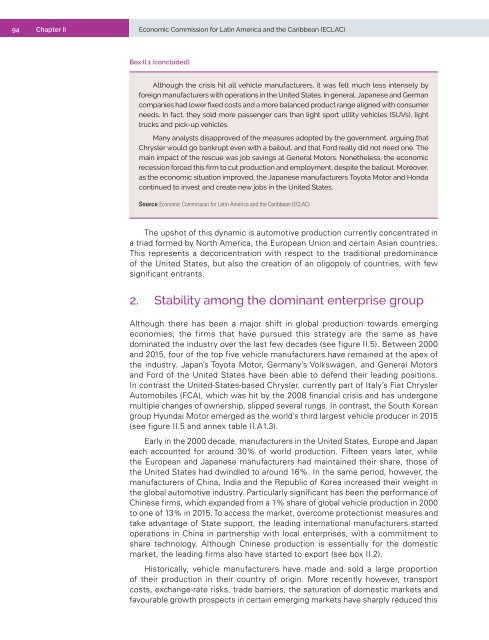Foreign Direct Investment in Latin America and the Caribbean 2017
This publication sets out and analyses the main foreign direct investment (FDI) trends in the countries of Latin America and the Caribbean. The 2017 edition shows that the region is at a difficult juncture. FDI inflows declined by 7.9% in 2016, to US$ 167.043 billion, representing a cumulative fall of 17.0% since the peak in 2011. The fall in commodity prices continues to affect investments in natural resources, sluggish economic growth in several countries has slowed the flow of market-seeking capital, and the global backdrop of technological sophistication and expansion of the digital economy has concentrated transnational investments in developed economies.
This publication sets out and analyses the main foreign direct investment (FDI) trends in the countries of Latin America and the Caribbean. The 2017 edition shows that the region is at a difficult juncture. FDI inflows declined by 7.9% in 2016, to US$ 167.043 billion, representing a cumulative fall of 17.0% since the peak in 2011. The fall in commodity prices continues to affect investments in natural resources, sluggish economic growth in several countries has slowed the flow of market-seeking capital, and the global backdrop of technological sophistication and expansion of the digital economy has concentrated transnational investments in developed economies.
Create successful ePaper yourself
Turn your PDF publications into a flip-book with our unique Google optimized e-Paper software.
94 Chapter II Economic Commission for Lat<strong>in</strong> <strong>America</strong> <strong>and</strong> <strong>the</strong> <strong>Caribbean</strong> (ECLAC)<br />
Box II.1 (concluded)<br />
Although <strong>the</strong> crisis hit all vehicle manufacturers, it was felt much less <strong>in</strong>tensely by<br />
foreign manufacturers with operations <strong>in</strong> <strong>the</strong> United States. In general, Japanese <strong>and</strong> German<br />
companies had lower fixed costs <strong>and</strong> a more balanced product range aligned with consumer<br />
needs. In fact, <strong>the</strong>y sold more passenger cars than light sport utility vehicles (SUVs), light<br />
trucks <strong>and</strong> pick-up vehicles.<br />
Many analysts disapproved of <strong>the</strong> measures adopted by <strong>the</strong> government, argu<strong>in</strong>g that<br />
Chrysler would go bankrupt even with a bailout, <strong>and</strong> that Ford really did not need one. The<br />
ma<strong>in</strong> impact of <strong>the</strong> rescue was job sav<strong>in</strong>gs at General Motors. None<strong>the</strong>less, <strong>the</strong> economic<br />
recession forced this firm to cut production <strong>and</strong> employment, despite <strong>the</strong> bailout. Moreover,<br />
as <strong>the</strong> economic situation improved, <strong>the</strong> Japanese manufacturers Toyota Motor <strong>and</strong> Honda<br />
cont<strong>in</strong>ued to <strong>in</strong>vest <strong>and</strong> create new jobs <strong>in</strong> <strong>the</strong> United States.<br />
Source: Economic Commission for Lat<strong>in</strong> <strong>America</strong> <strong>and</strong> <strong>the</strong> <strong>Caribbean</strong> (ECLAC).<br />
The upshot of this dynamic is automotive production currently concentrated <strong>in</strong><br />
a triad formed by North <strong>America</strong>, <strong>the</strong> European Union <strong>and</strong> certa<strong>in</strong> Asian countries.<br />
This represents a deconcentration with respect to <strong>the</strong> traditional predom<strong>in</strong>ance<br />
of <strong>the</strong> United States, but also <strong>the</strong> creation of an oligopoly of countries, with few<br />
significant entrants.<br />
2. Stability among <strong>the</strong> dom<strong>in</strong>ant enterprise group<br />
Although <strong>the</strong>re has been a major shift <strong>in</strong> global production towards emerg<strong>in</strong>g<br />
economies, <strong>the</strong> firms that have pursued this strategy are <strong>the</strong> same as have<br />
dom<strong>in</strong>ated <strong>the</strong> <strong>in</strong>dustry over <strong>the</strong> last few decades (see figure II.5). Between 2000<br />
<strong>and</strong> 2015, four of <strong>the</strong> top five vehicle manufacturers have rema<strong>in</strong>ed at <strong>the</strong> apex of<br />
<strong>the</strong> <strong>in</strong>dustry. Japan’s Toyota Motor, Germany’s Volkswagen, <strong>and</strong> General Motors<br />
<strong>and</strong> Ford of <strong>the</strong> United States have been able to defend <strong>the</strong>ir lead<strong>in</strong>g positions.<br />
In contrast <strong>the</strong> United-States-based Chrysler, currently part of Italy’s Fiat Chrysler<br />
Automobiles (FCA), which was hit by <strong>the</strong> 2008 f<strong>in</strong>ancial crisis <strong>and</strong> has undergone<br />
multiple changes of ownership, slipped several rungs. In contrast, <strong>the</strong> South Korean<br />
group Hyundai Motor emerged as <strong>the</strong> world’s third largest vehicle producer <strong>in</strong> 2015<br />
(see figure II.5 <strong>and</strong> annex table II.A1.3).<br />
Early <strong>in</strong> <strong>the</strong> 2000 decade, manufacturers <strong>in</strong> <strong>the</strong> United States, Europe <strong>and</strong> Japan<br />
each accounted for around 30% of world production. Fifteen years later, while<br />
<strong>the</strong> European <strong>and</strong> Japanese manufacturers had ma<strong>in</strong>ta<strong>in</strong>ed <strong>the</strong>ir share, those of<br />
<strong>the</strong> United States had dw<strong>in</strong>dled to around 16%. In <strong>the</strong> same period, however, <strong>the</strong><br />
manufacturers of Ch<strong>in</strong>a, India <strong>and</strong> <strong>the</strong> Republic of Korea <strong>in</strong>creased <strong>the</strong>ir weight <strong>in</strong><br />
<strong>the</strong> global automotive <strong>in</strong>dustry. Particularly significant has been <strong>the</strong> performance of<br />
Ch<strong>in</strong>ese firms, which exp<strong>and</strong>ed from a 1% share of global vehicle production <strong>in</strong> 2000<br />
to one of 13% <strong>in</strong> 2015. To access <strong>the</strong> market, overcome protectionist measures <strong>and</strong><br />
take advantage of State support, <strong>the</strong> lead<strong>in</strong>g <strong>in</strong>ternational manufacturers started<br />
operations <strong>in</strong> Ch<strong>in</strong>a <strong>in</strong> partnership with local enterprises, with a commitment to<br />
share technology. Although Ch<strong>in</strong>ese production is essentially for <strong>the</strong> domestic<br />
market, <strong>the</strong> lead<strong>in</strong>g firms also have started to export (see box II.2).<br />
Historically, vehicle manufacturers have made <strong>and</strong> sold a large proportion<br />
of <strong>the</strong>ir production <strong>in</strong> <strong>the</strong>ir country of orig<strong>in</strong>. More recently however, transport<br />
costs, exchange-rate risks, trade barriers, <strong>the</strong> saturation of domestic markets <strong>and</strong><br />
favourable growth prospects <strong>in</strong> certa<strong>in</strong> emerg<strong>in</strong>g markets have sharply reduced this


















